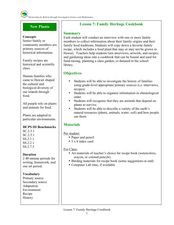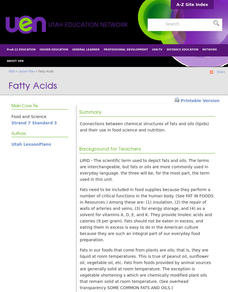Curated OER
The shop is important
Pupils consider where food comes from and how it gets to them. They identify where shops are found and visit one to investigate how it operates.
Curated OER
How Much Is There To Eat?
Tenth graders compare the relationship of food production and population in India with the southern regions of the United States.
Curated OER
You Are What You Eat!
Young scholars calculate the calorie content of food. In this chemistry activity, students plan a healthy meal based on RDA. They devise an exercise to burn extra calories.
Curated OER
Primary Productivity in Headwater (deciduous Dominated) Streams in Winter
Students study outside sources of energy that are associated with the headwater streams in northern Michigan. They study how leaf fall is an important food source for macroinvertebrates and how photosynthesis drives the production of...
Curated OER
Termite trails
Students observe termite trail-following behavior. Termites tend to follow lines made on paper by ballpoint pens because the ink contains a chemical that is similar to the trail pheromones used by termites to lead colony members to food...
Curated OER
What is Money? Learn the Role of Money in a Free Market System
Pupils view a seashell and listen as the teacher explains that these were sometimes used as money. They listen as the teacher lectures on medium of exchange, barter, and commodity. Students determine the number of chickens it would take...
Curated OER
DNA Blueprint for Life
Students isolate DNA from different food sources. In this biology instructional activity, students research DNA extraction. They analyze DNA stands collected from the lab, and compare the differences between each.
Curated OER
You Are What You Eat (Grades 5-8)
Students gain an enhanced understanding of the relationship between proper nutrition and good health. Through use of video, hands-on activities and interaction, students measure energy in food, and recognize sources of vitamins and...
Curated OER
Dietary Fiber
Students examine the different types of fiber and their benefits. In this investigative lesson plan students find good sources of fiber in different foods.
Curated OER
Family Heritage Cookbook
Learners compare favorite family recipes. In this cultural diversity lesson, students interview family members and record favorite recipes. Learners examine cultural diversity through favorite foods.
Curated OER
Non-nutrients: Fiber and Water
Students will identify the sources and function of carbohydrates and fiber and apply appropriate food preparation techniques.
Curated OER
Fiber - Adding it to the Diet - Skill Supplement
Food preparation that supports the concepts of adding fiber and water to the diet. Identify fiber, its sources and functions. National Standard 14.2.1 Identify the function of fiber Identify cellulose - non digestible fiber Discuss the...
Curated OER
Native Americans in Utah History: Research Project
Students research the basic cultural information available on the various Native American cultures of Utah. They investigate the historical time period, shelters, weapons, tools, foods and methods of obtaining food.
Curated OER
Fatty Acids
Identify the properties of fats and lipids. Compare the properties of saturated and unsaturated fatty acids Identify foods containing triglycerides and identify which foods contain saturated and unsaturated fat Discuss the function of...
Curated OER
Giants of the Animal Kingdom
Fourth graders examine the megafauna found in Australia. They create a food web using cut-outs and develop a timeline to show changes in the fauna over time. They draw their own megafauna scene for their classroom.
Curated OER
I Feel Renewed!
Students participate in a simulation of the equal and unequal distribution of the earth's renewable resources. They discuss renewable resources and how food resources can increase and decrease, participate in the simulation, and analyze...
Curated OER
Pollinator Habitats
Students read and discuss background information included with this lesson. They brainstorm the best sources for developing a list of native or migratory pollinators. Students work in groups to design habitats based on information...
Curated OER
Dispersement of Particles: Diffusion and Osmosis
Students explore the dispersement of particles. In this science lesson plan, students describe the many ways in which particles move and transfer from one source to other areas.
Curated OER
Social Studies and Economics
Students investigate the products agriculture provides in raw materials. In this agriculture products lesson, students make a list of common items used and foods eaten. Students work in teams to categorize agriculture products based on...
Curated OER
Protein - Complete and Incomplete
The relationship between how an individual looks and feels and the nutrients he or she eats. Identify proteins (complete and incomplete), their sources, and functions in the body. National Standard 14.2.1 Define amino acids, complete and...
Curated OER
Make Mine Turkey
Young scholars compare foods available for the Pilgrims' Thanksgiving with contemporary Thanksgiving foods. After reading information about the first Thanksgiving, pupils create a menu and compute the cost of a turkey dinner, using...
Curated OER
WHAT'S ORGANIC?
Students explore how certain foods come to be certified "organic." They write the words "organic" and "synthetic" and given the definitions of each. Students are given dictionaries. They are asked: "What is organic food?" Students grow...
Curated OER
Photosynthesis Cookies
Students identify photosynthesis as a process through which organisms make their own food. They practice the process for writing the formula for the photosynthesis equation.
Students describe how the processes of photosynthesis and...
Curated OER
Surrounded by Radiation
Students explore ways in which people are constantly exposed to naturally occurring and man-made sources of radiation. They create and play a board game featuring different hypothetical scenarios of radiation exposure.

























